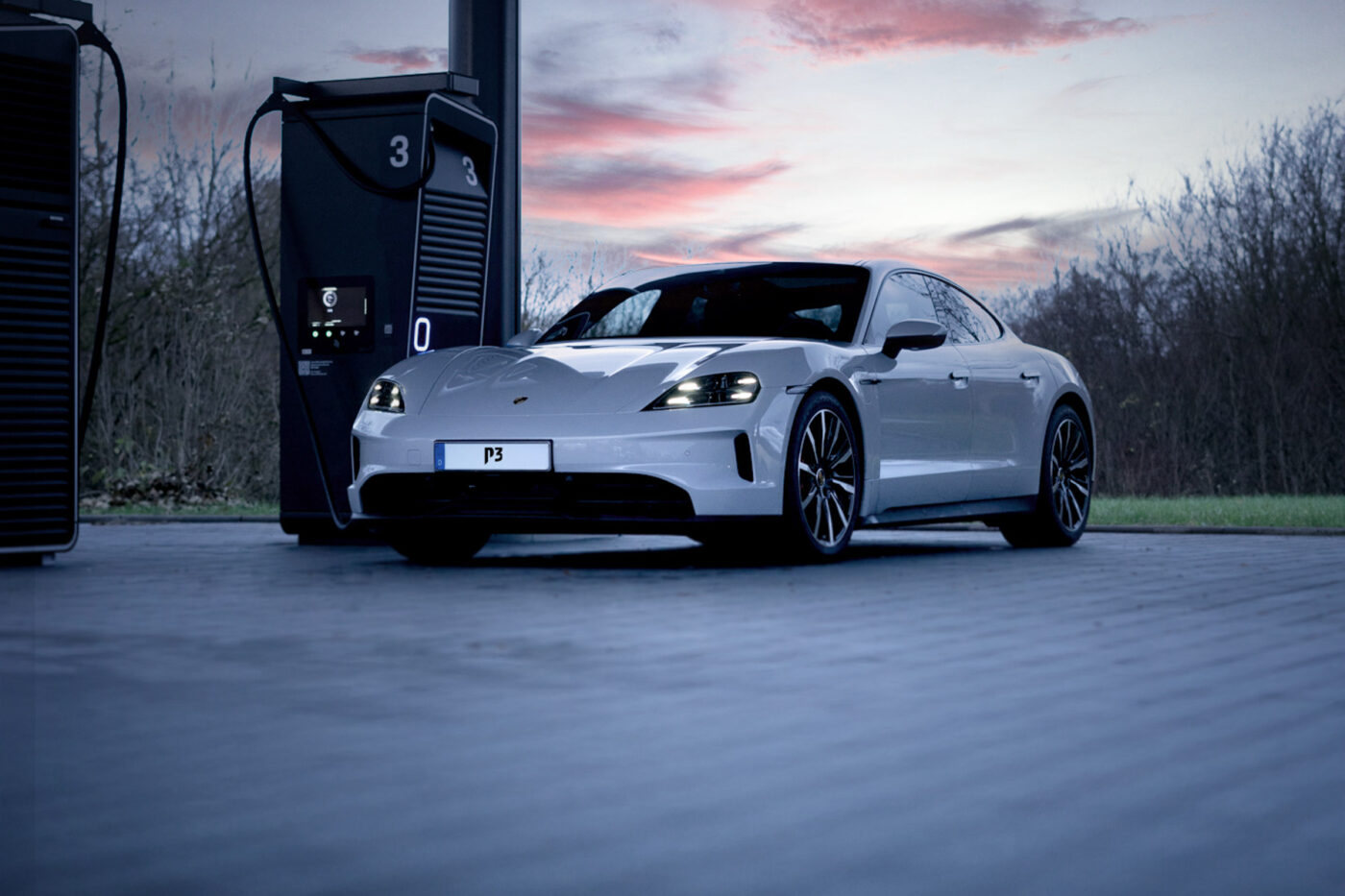
P3 Charging Index 2024: Porsche Taycan is the long-distance champion
In what was then the third edition in the summer of 2022, the Kia EV6 was the first electric car from South Korea to win. In the second edition in 2021, the Mercedes EQS came out on top. And the winner of the current, fourth edition is practically a familiar face: The Porsche Taycan had already won the first edition at the end of 2019 – five years later, the facelift model came out on top in the long-distance comparison.
To determine long-distance suitability, management consulting firm P3, which specialises in electric mobility, primarily uses two factors: energy consumption and the charging behaviour of electric cars. These two points are considered to be more important than the size of the battery alone, as electric cars in a comparable segment often have very similar batteries. Actual consumption and the charging curve are then more relevant for long journeys than the difference between a battery with 77.4 kWh or 79 kWh – as will be shown later in the text.
P3 has not changed the methodology for the fourth edition. The definition of being able to recharge electricity for a range of 300 kilometres in 20 minutes remains the same – this corresponds to a charging index of 1. If an electric car can recharge even more range in 20 minutes, the index value achieved is above 1 – the Kia EV6 was the first car to break this ideal value in 2022 with 1.03.
300 kilometres in 20 minutes is the goal
The EV6 achieved exactly this index value again in 2024 – in 20 minutes, it was possible to recharge electricity for 309 kilometres, which resulted in a charging index of 1.03. The ‘problem’ for the EV6: the competition never sleeps. In 2024, it was not enough for first place either in the overall ranking or in the newly tailored mid-range category.
Compared to the third edition, the division into three classes has been changed – in 2022, P3 roughly based the categorisation on the environmental bonus in force in Germany at the time. Since that no longer exists, the categorisation was also obsolete. In the 2024 edition, there are only two categories, the mid-range and luxury class – these are separated at a gross list price of 62,500 euros. A special small car category was omitted – there were too few new models that were already available for the test. However, there is a lot of movement in the segment, numerous models just launched or are about to – for example, a Citroën ë-C3 with its offshoots from Fiat and Opel, the Hyundai Inster, possibly a Kia EV2, the Renault R5 (and R4), small electric cars from China such as the Leapmotor T03 and of course the long-announced €25,000 electric cars from the VW Group from the ID.2 to the Skoda Epiq. So this segment will again be interesting for the next editions!
The last point in the preface is the database. Power consumption for all models is based on the ADAC EcoTest, as this test is always carried out under the same conditions on the test bench and is the only way to ensure true comparability between the models. That is why, for example, the Lotus Emeya, which impressively won the first P3 Charging Index Asia this May, is not included in this evaluation: there is no ADAC EcoTest for the Emeya and thus no basis for comparison with the other models. For the Asia edition, P3 used the WLTP consumption figures. Although it is easier for international comparisons, the EcoTest depicts more realistic consumption figures – and thus results in a better Charging Index. P3 measured all charging curves itself.
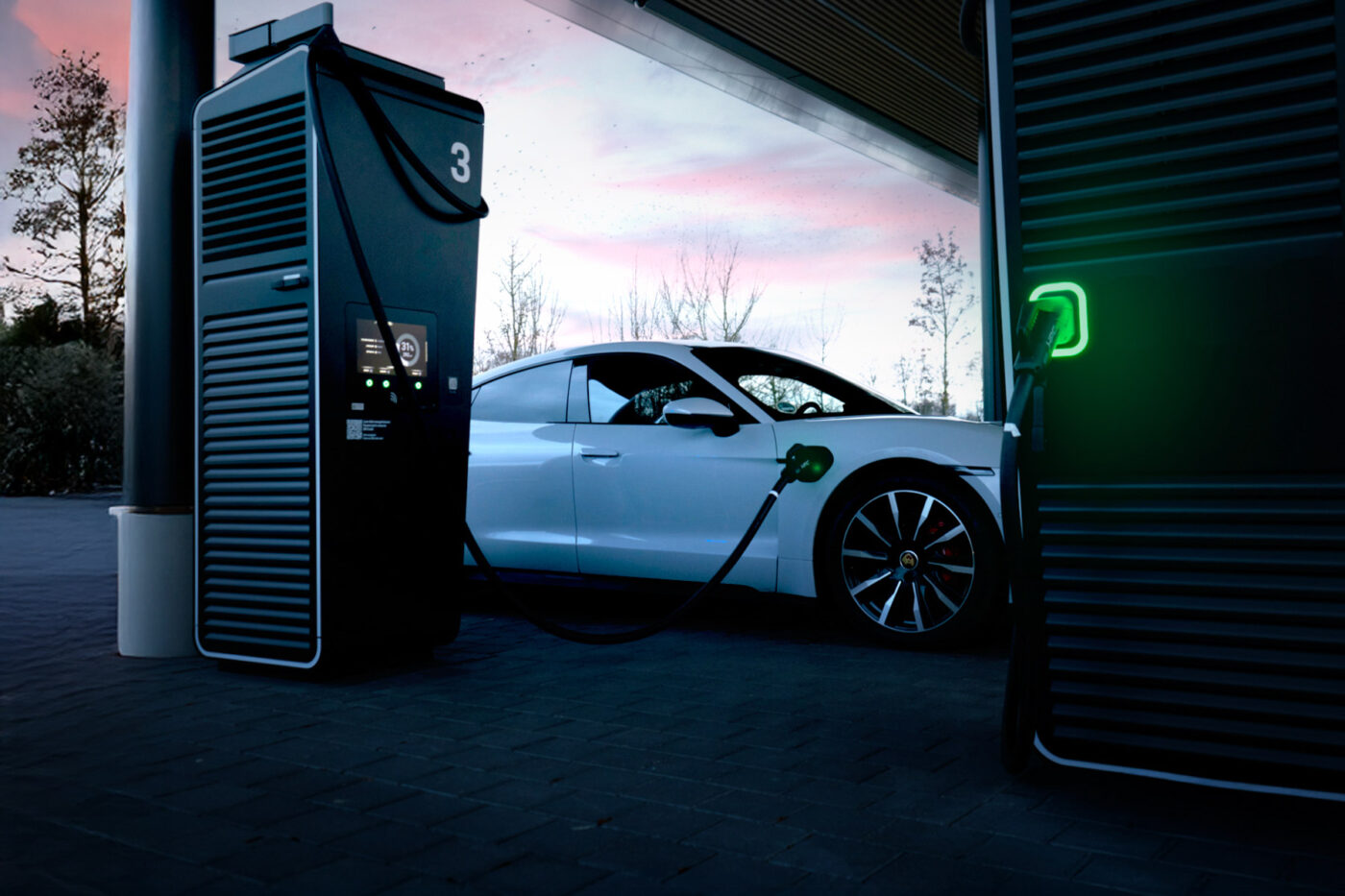
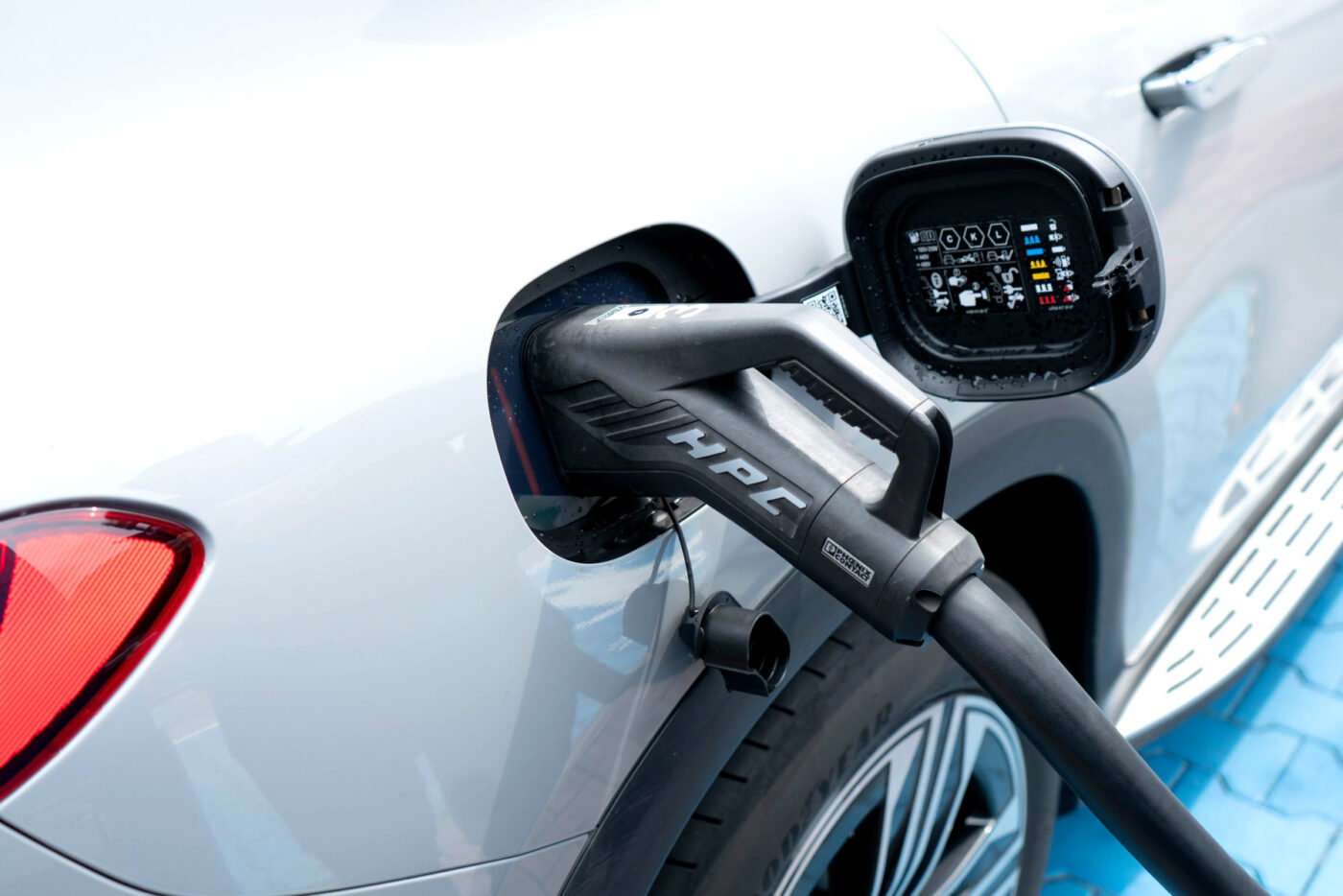
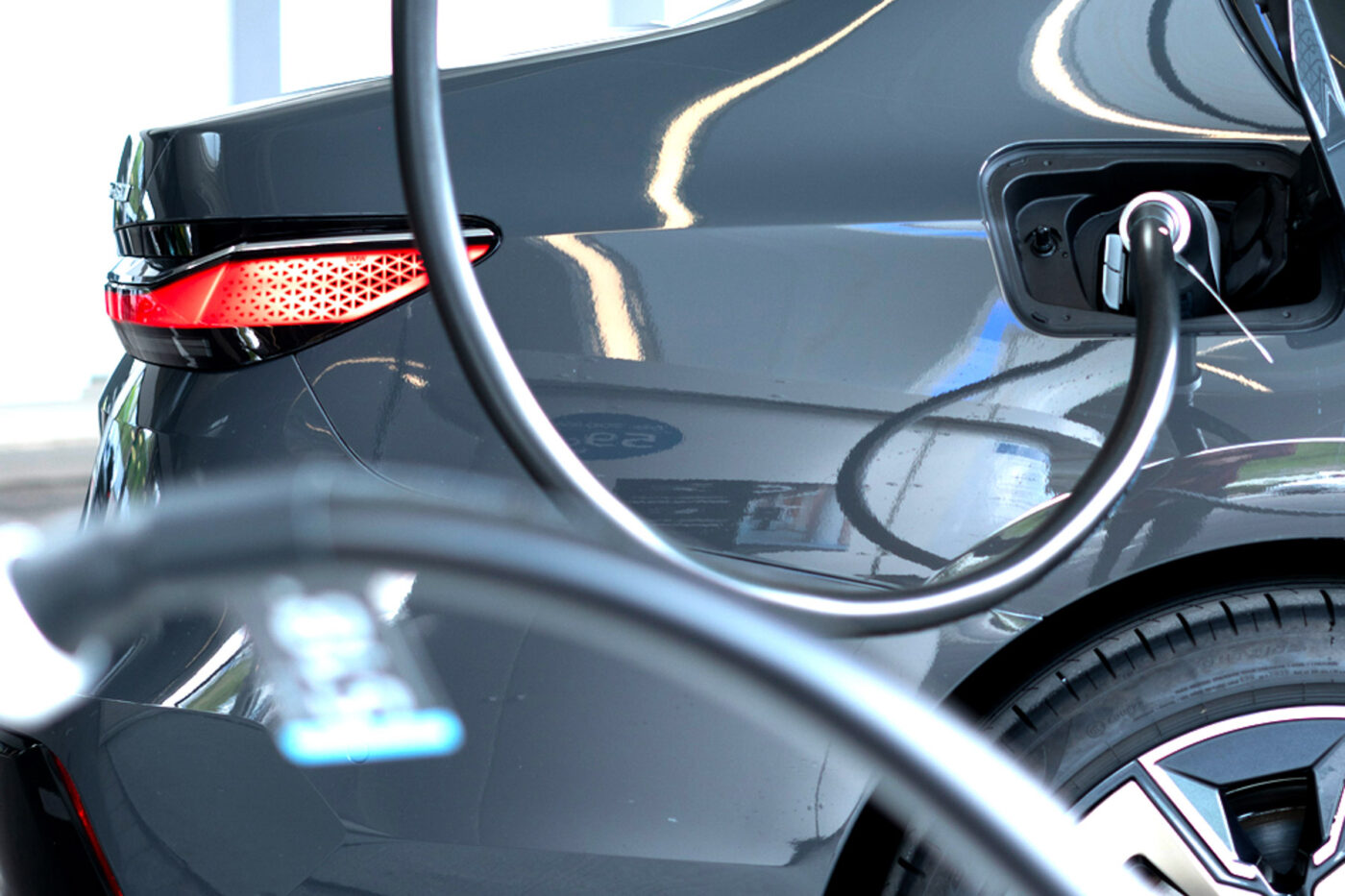
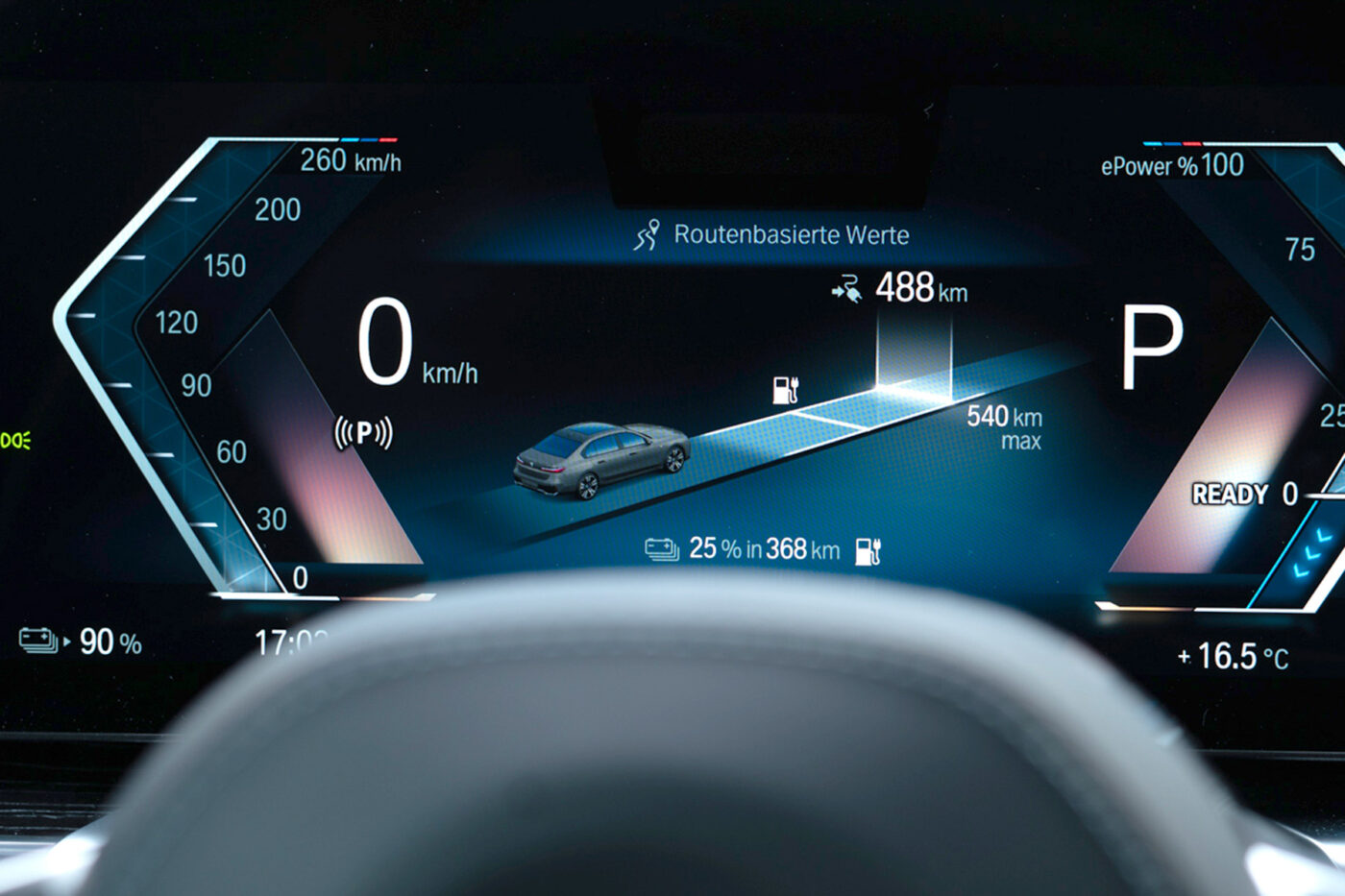
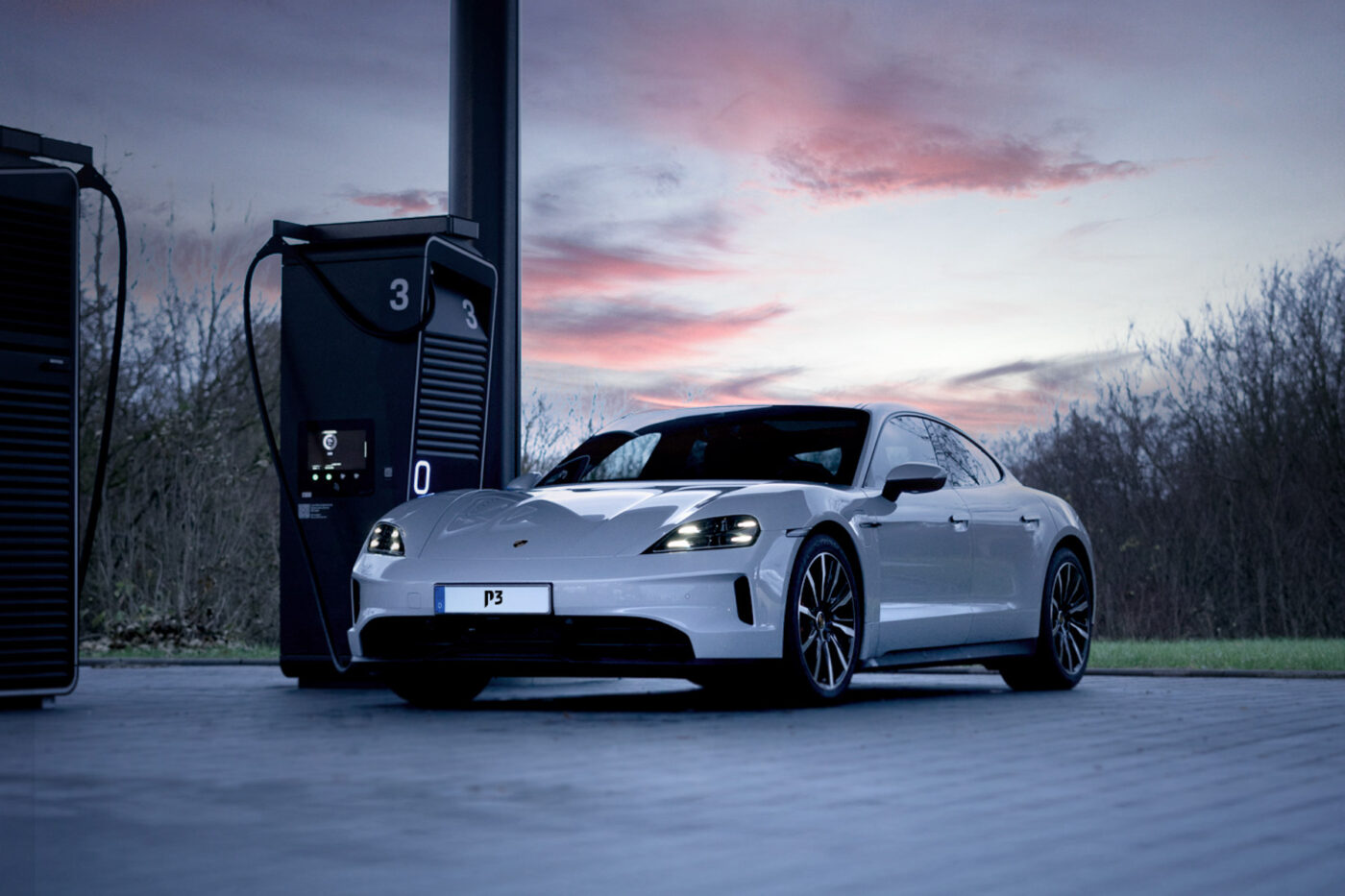
The luxury category includes vehicles such as the BMW i5 in its longest-range variant eDrive40, the Xpeng G9 Performance, the Mercedes EQS 450+ as the 2021 winner, but also electric cars from Genesis, the Kia EV9 or the Nio ET5 Touring – and the Taycan, which Porsche gave a visual (and relevant here) technical overhaul at the beginning of the year. Instead of leaving the still competitive technology out of the model update, the German carmaker installed an optimised electric drive and a new generation of batteries, which offer a higher energy density and a further improved charging curve. The batteries in the luxury category are between 77.4 and 107.8 kWh (net), with prices for the vehicles ranging from 68,500 euros (Nio ET5 Touring) to 139,000 euros for the BMW i7 xDrive60.
In a comparison of the charging curves, the Taycan not only shines with the highest peak charging power, but also with an extremely long plateau: the Porsche can maintain the power at more than 300 kW up to over 60 per cent charge level – after that it drops to around 200 kW up to around 75 per cent, before the charging power then drops rapidly. Only in the range between ten and 20 per cent and just before 80 per cent does the Xpeng G9 actually have a higher charging power – the G9 also surprised us in our test with a peak charging power of 320 kW. However, unlike the Taycan, the electric SUV from China has several stages at which the charging power is regulated. Nevertheless, 233 kW on average is the second-best result – no other electric car comes close to the Porsche’s 282 kW.
Combination of charging performance and consumption
Other models from Asia are also striking, such as the Kia EV9 and the Genesis Electrified G80, both of which offer a consistently high charging capacity over a wide range. And the Nio ET5 Touring leads the field of 400-volt models. With the new generation of the long-range battery, it does not come close to the 200 or 300 kW of the 800-volt models at peak. But with an average of 175 kW, its charging curve is extremely flat, and at charge levels of 65 per cent and above, it even beats some 800-volt models. The 400-volt models from German car manufacturers, on the other hand, have to reduce their charging power much earlier. Although the BMW i5 and the Mercedes EQS initially manage 200 kW, the charging curve drops significantly from 40 per cent.
The Charging Index is not a comparison of charging curves, but of the long-distance capability. However, a lower charging power at a high charge level can have a negative impact on the recharged range in the second ten minutes. But let’s first take a look at the consumption data. Here, the i5 eDrive40 and the Mercedes Benz EQE SUV 350+ are two models at the top of the list, which were only at the back of the pack in terms of charging power at 155 and 146 kW, respectively. With 19.1 kWh/100km, the i5 is the most efficient car in the luxury category, even if the EcoTest’s markup on the WLTP value is still 17 per cent. The EQE SUV is the most efficient SUV with 19.2 kWh/100km; here, the EcoTest markup on the WLTP is only eight per cent. The Porsche Taycan follows in third place with 19.7 kWh/100km – and it is foreseeable that the Porsche, with its superior charging performance and third-best consumption, will be difficult to beat.
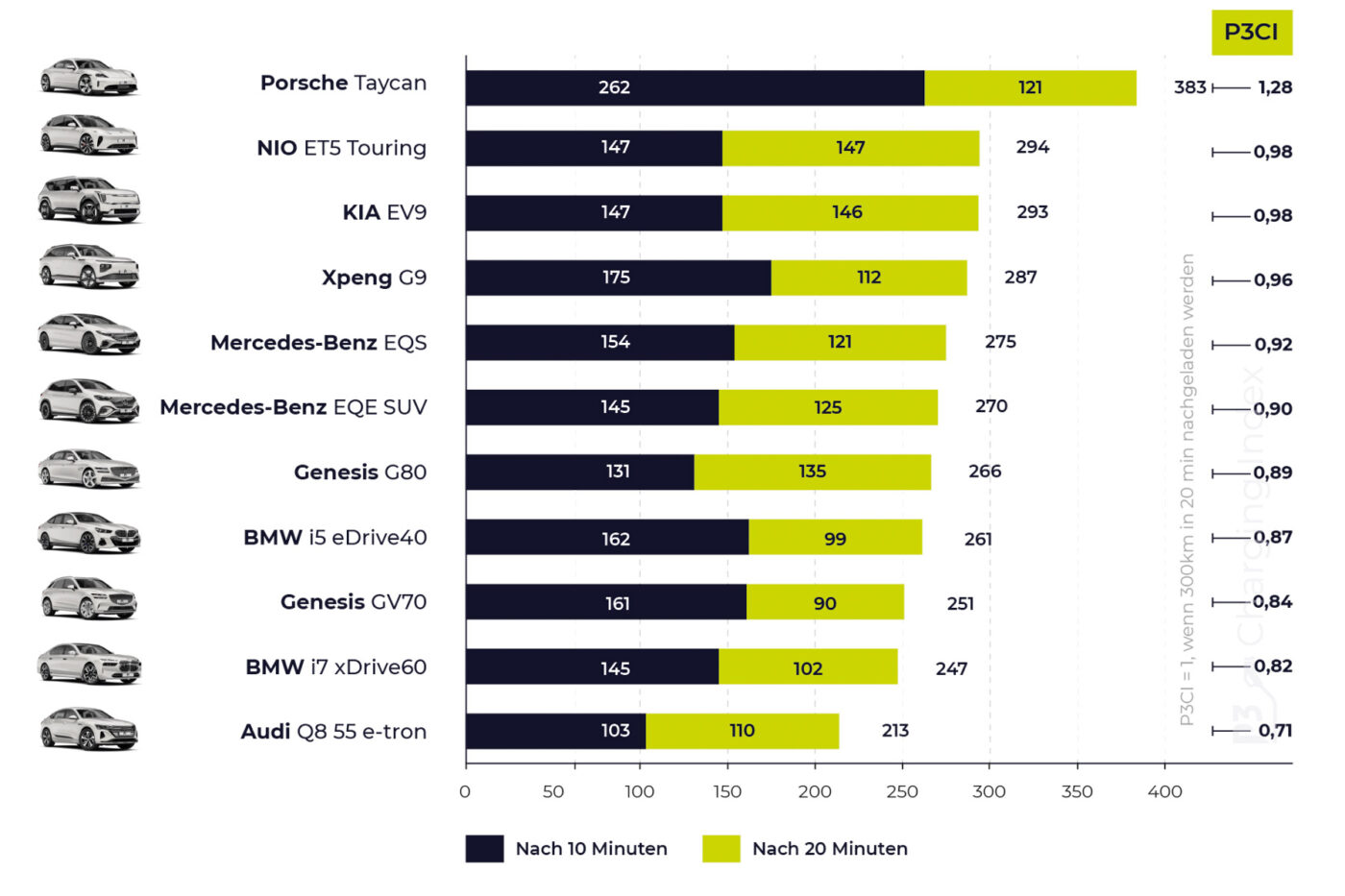
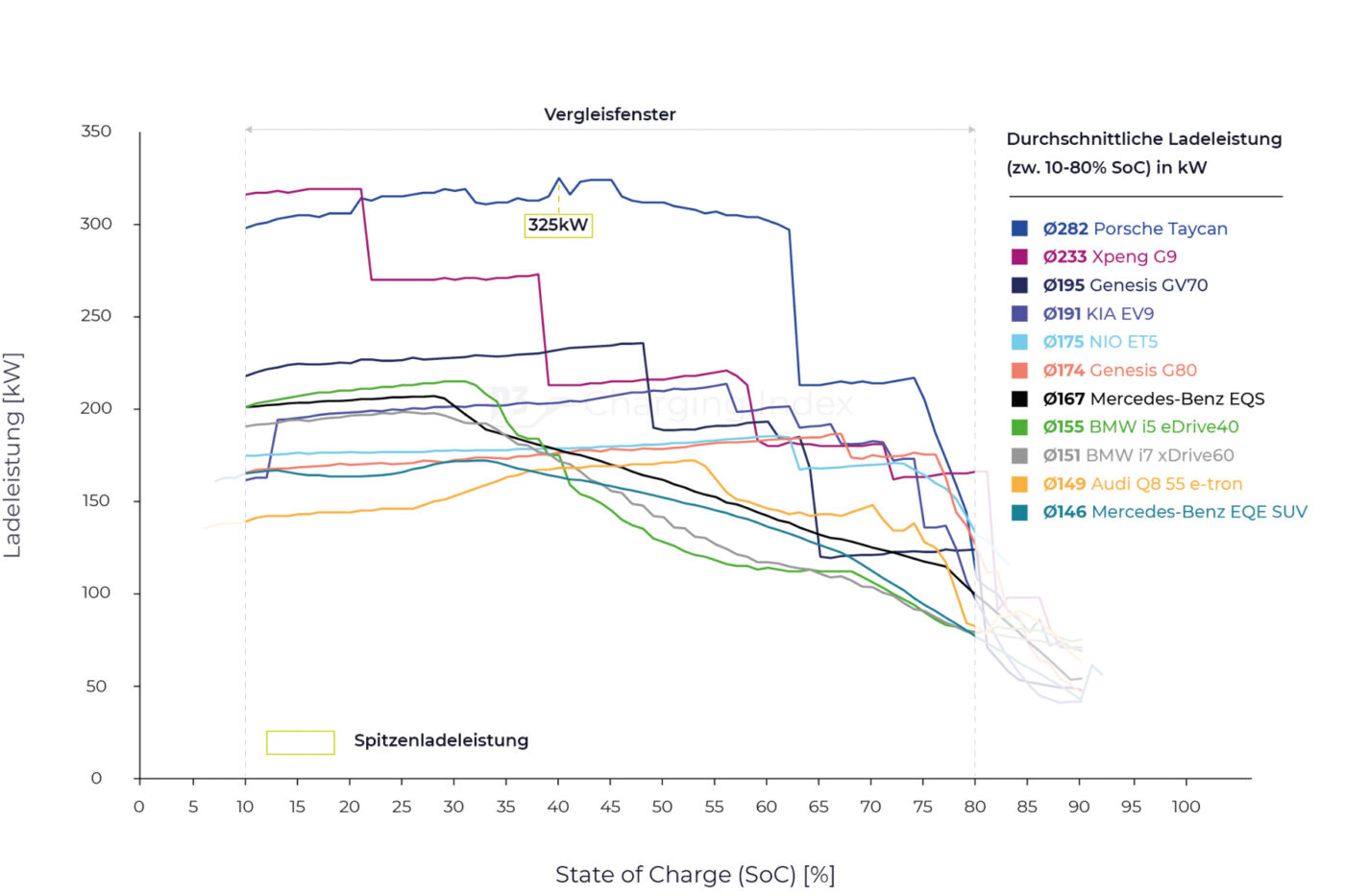
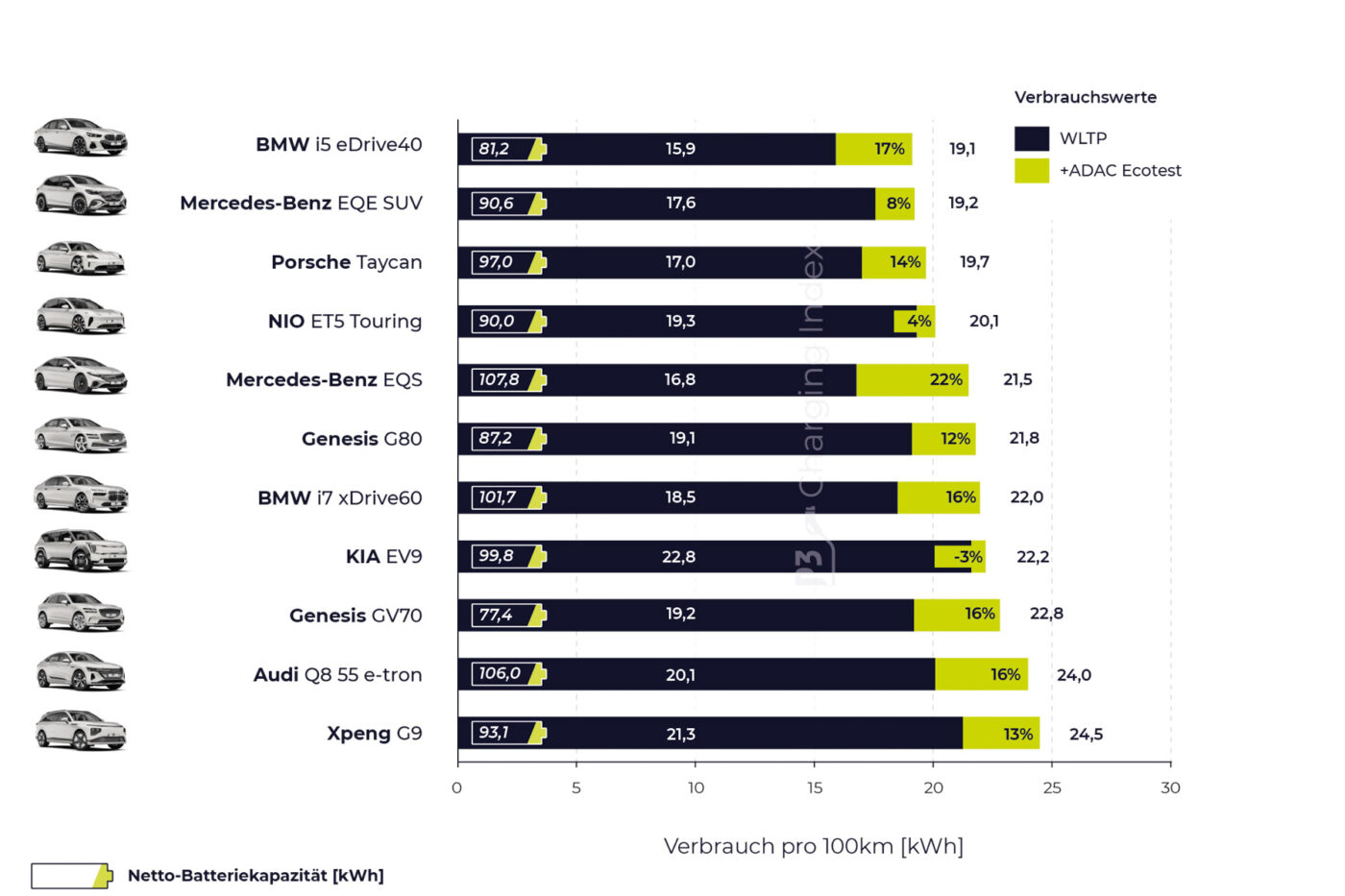
The Nio ET5, for example, is also worth mentioning in the energy consumption chapter, as it performs remarkably well with only a four per cent increase and 20.1 kWh/100km. The result of the Kia EV9 is also unusual, with 22.2 kWh/100km in the EcoTest, which is even three per cent below its WLTP consumption (22.8 kWh/100km). The Xpeng G9, which was almost able to keep up with the Taycan in the charging chapter, makes it clear why it is ultimately not enough for a top position in the Charging Index: at 24.5 kWh/100km, its consumption is even higher than that of the Audi Q8 e-tron.
Combining these two factors, there can only be one winner in the luxury category (and also in the overall ranking): the Porsche Taycan. With its low consumption and long charging plateau of over 300 kW, the Taycan can recharge for 262 kilometres in the first ten minutes! In comparison: the i5 manages 261 kilometres in 20 minutes, the i7 247 kilometres and the ageing Q8 e-tron only 213 kilometres – the latter corresponds to a charging index of 0.71, while the 2024 Taycan sets a new record of 1.28. In Audi’s defence, however, it should be mentioned: In the first Charging Index in 2019, the Taycan only achieved a value of 0.72. Overall victory at the time, but five years later last place in the luxury class. That shows how dynamic the development is.
That is also clear from the second to fourth places: both the Nio ET5 Touring and the Kia EV9 achieve an index value of 0.98, closely followed by the Xpeng G9 with 0.96. The Nio and Kia benefit from their constant charging performance, they can recharge more range than the Taycan in the second half of the 20-minute charging process with 147 and 146 kilometres respectively. After 20 minutes, the results are 294 and 293 kilometres respectively. Although the Xpeng can beat the Nio and Kia in the first half with 175 kilometres, its consumption is too high to be able to recharge enough range with decreasing charging power in the second half. It would be interesting to see this drive system used in a flatter and more efficient car.
Consumption alone is not enough for a top result
However, the BMW i5 eDrive40 shows that efficiency is not everything with the lowest consumption in the luxury class evaluation. With a charging index of 0.87, the business saloon from Munich comes in eighth place. At 81.2 kWh, the i5 has one of the smaller batteries in this competitive field. With a larger battery, it is easier to achieve a good charging performance even with a high charge level without affecting the longevity – you can read more about the durability of batteries here. The i5 also relies on a 400-volt system, and BMW is also set to switch to 800 volts in 2025 with the Neue Klasse – we are already looking forward to the next edition of the Charging Index. But the 2024 edition also shows that 800 volts is not an end in itself: The Genesis Electrified G80 is just one place ahead of the i5, with the Electrified GV70 right behind. It also depends on consumption.
A few brief words about the Nio ET5 Touring: With a Charging Index of 0.98, the Chinese estate is the best 400-volt model ever measured for the P3 Charging Index. However, not every ET5 travelling in Germany will achieve the almost constant charging power of 175 kW – it depends on which generation of the long-range battery is installed. With the older generation, the peak is around 130 kW; in the range between ten and 80 per cent, it would only be around 90 kW on average. That would be by far the last place in the luxury category. With the new battery generation, however, the charging capacities measured by P3 are possible. The catch: if you use the typical Nio battery swap, you don’t know which 100 kWh battery will be screwed into the underbody. The charging behaviour can thus change after each battery change. On the other hand, if you use the battery swap and get a battery with a ten per cent charge level replaced by one with a 90 per cent charge level in just five minutes, this results in a charging index of 4.23! We recently tested how the Nio Power Swap Stations (PSS), which currently has 31 stations in Germany, perform with an EL6. The EV is based on the same platform as the ET5, but as an SUV it has a higher consumption.
In the mid-range up to 62,500 euros, there are no technology flagships such as the Taycan or the Xpeng G9, even if the latter could also compete in the mid-range with the smaller standard range battery and a price of 59,600 euros – but then not with over 300 kW charging power. However, the Charging Index from 2022, when the Kia EV6 was able to beat its expensive premium competitors, already showed that long-distance charging doesn’t have to be slow even below the luxury class. And this year, too, the best mid-range model can outperform many more expensive electric cars.
The field includes models such as the Smart #1 Pro+, the MG4 Luxury and the Opel Astra Sports Tourer GS, all of which are listed at just over €40,000. Although the Astra has by far the smallest battery in the category with 51 kWh, Opel has placed great emphasis on efficiency. In addition, there are several business and family saloons from the Tesla Model 3 in the longest-range variant ‘Maximum Range Rear Wheel Drive,’ the VW ID.7 Pro, BMW i4 or Hyundai Ioniq 6. At 60,500 euros, the i4 eDrive40 is the most expensive representative of the mid-range, measured against the base price. With their long surcharge lists, the BMWs in the test (including the iX1 xDrive30) and the Audi Q4 40 e-tron, for example, can be brought into completely different price ranges. With Tesla, the Polestar 2 or the Hyundai Ioniq 6, the configuration is much simpler.
800-volt systems offer better charging performance
But that’s not the point, it’s about the Charging Index. Let’s first look at the charging performance. The Tesla Model 3 with the extensive Highland facelift achieves the highest peak power of 255 kW. However, this maximum charging power is only achieved at Tesla’s own Superchargers. These charging stations charge the Model 3 with more than 600 amps – which is necessary to achieve more than 200 kW charging power with the 400-volt architecture. With the usual 500 amps for CCS, 200 kW would be the limit. It is thus the two 800-volt electric vehicles on Hyundai’s E-GMP platform that offer the better overall charging performance with around 235 kW at peak. Even with the Highland facelift, Tesla can only maintain the peak for a very short time, after which the charging performance drops rapidly – with an average of 135 kW, it is only enough to place in the midfield. Of course, this only applies if the charging window of ten to 80 per cent is considered, as is the case here. If you need to recharge for a few kilometres shortly before reaching your destination, the Model 3 can really score points. However, if you want to charge a lot of electricity because you want to continue for 250 or 300 kilometres without a break, things get rather tough at the top end with many mid-range cars – the Model 3 is less than 100 kW from a charge level of around 60 per cent.
The Kia EV6 and Hyundai Ioniq 6 do not yet fall into these ranges, even at 80 per cent charge level. Although both models had the 77.4 kWh battery (the 84 kWh version is due for the next issue), they have slightly different charging curves. The EV6 has an average of 203 kW, while the Ioniq 6 still has 193 kW. This is followed by a tight midfield with the revised Polestar 2 Long Range Single Motor (141 kW), the ID.7 Pro (138 kW), the i4 (136 kW), the aforementioned Model 3 (135 kW) and the Audi Q4 e-tron (125 kW). Even the MG4 is not far behind with 118 kW. The iX1 performs rather poorly with an average of 106 kW. The Opel Astra has to score points for consumption, as its charging power is only 100 kW at peak – and 83 kW on average.
Ioniq 6 combines good consumption and charging performance
In fact, the Astra is one of the more efficient cars with the third-best consumption in the EcoTest at 17.4 kWh/100km. It is only just beaten by the Model 3 with 17.2 kWh/100km – although the Tesla is significantly better in the WLTP value, a whopping 23 per cent increase in the EcoTest cost the Model 3 first place. However, the ADAC should not be accused of Tesla bashing: The VW ID.7 Pro also has extremely good WLTP consumption, but also consumed significantly more in the EcoTest with a 22 per cent premium – making 18.1 kWh/100km in the evaluation. The Hyundai Ioniq 6 has a very low deviation (8%) with a very good WLTP value: the Korean was tested by the ADAC with 15.5 kWh/100km, which is an extremely good value – and clearly undercuts the most efficient electric car in the luxury class, the BMW i5 with 19.1 kWh/100km.
P3 also emphasises the further development of the MEB from Volkswagen in the results: in 2021, the ID.4 Pro still achieved an EcoTest consumption of 22.8 kWh/100km. With the significantly more efficient APP550 electric motor and the aerodynamic saloon shape, the ID.7 achieves a good value of 18.1 kWh/100km. The Audi Q4 40 e-tron, on the other hand, only comes second to last with 20.4 kWh/100km – 0.1 kWh ahead of the Smart #1 Pro+.
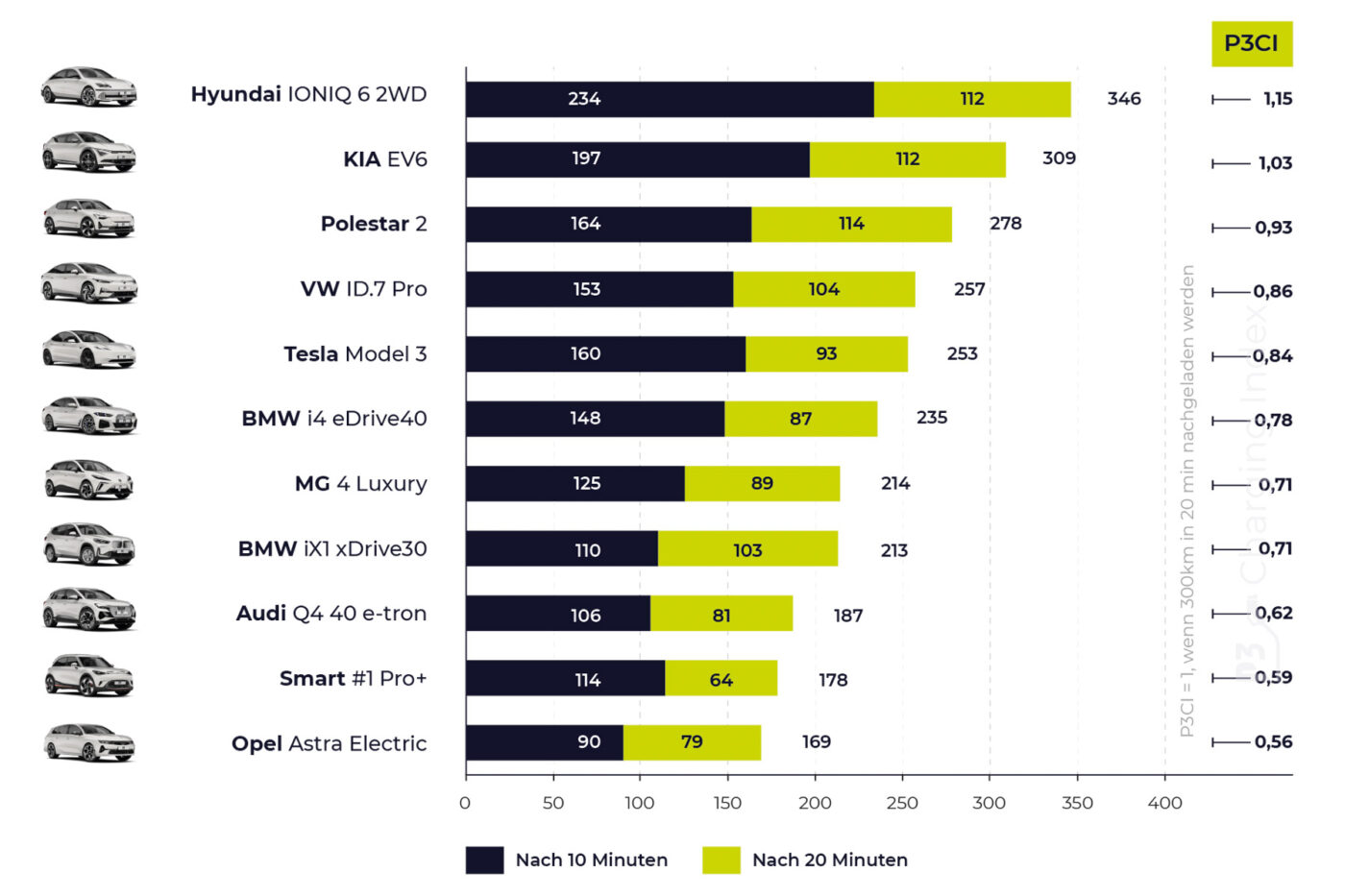
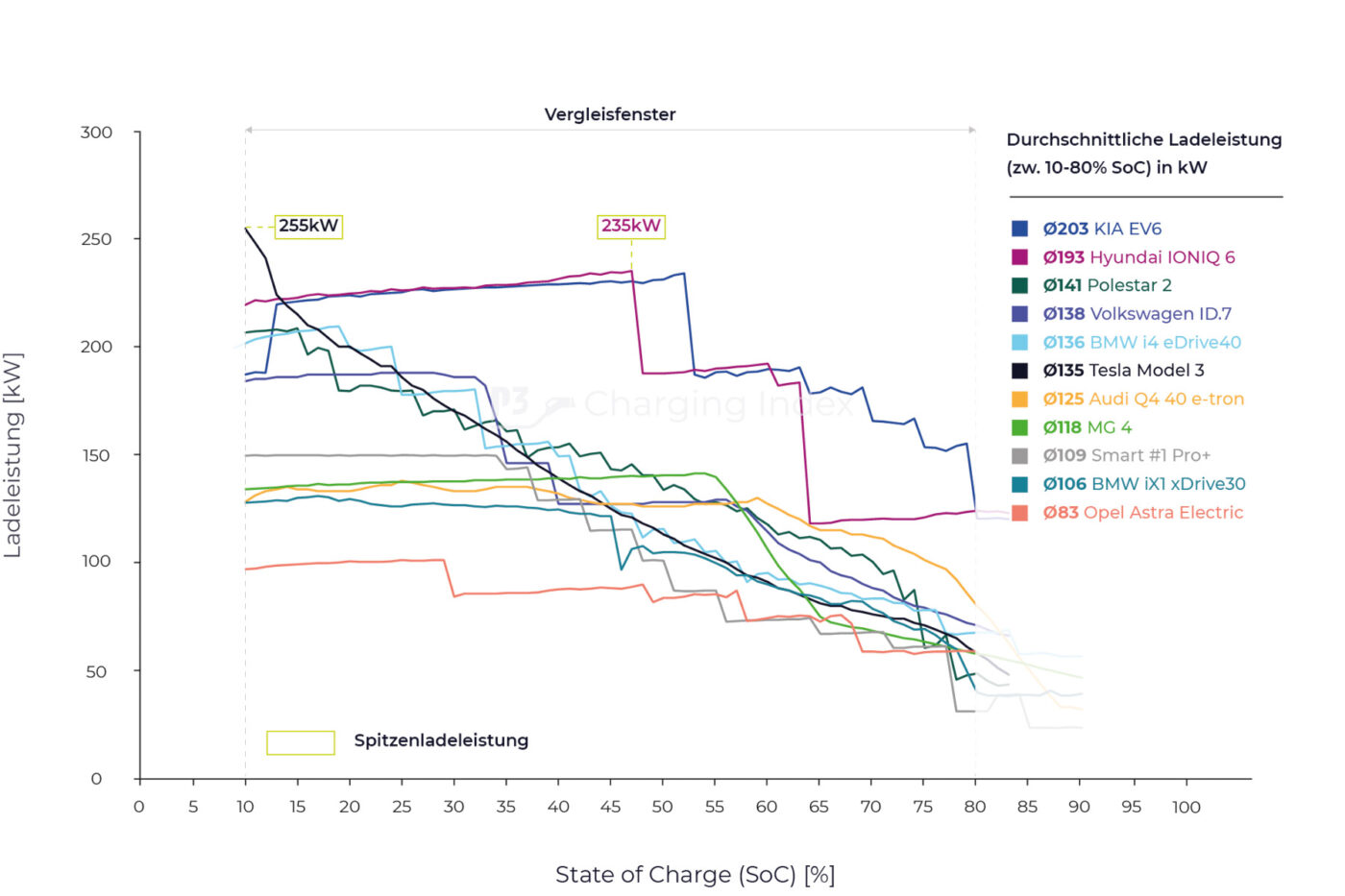
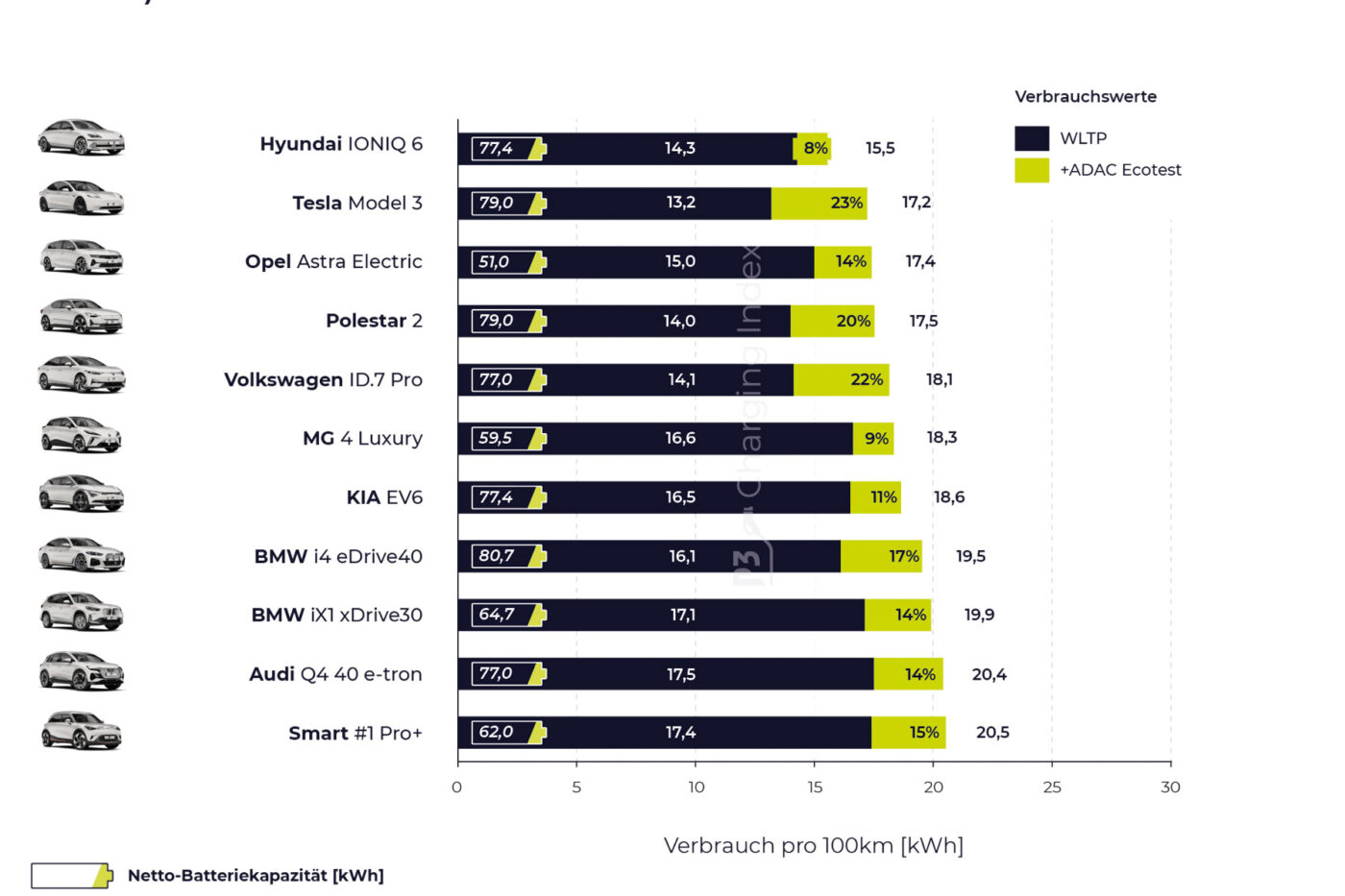
If you combine consumption with charging performance, the clear winner in the mid-range is the Hyundai Ioniq 6 RWD! The e-GMP saloon combines low consumption and charging performance better than any other model in its price class. Although the EV6 charges slightly better, its consumption is significantly higher at 18.6 kWh/100 km – only 7th place in the segment. However, if you need the significantly larger boot of the EV6 compared to the flat electric saloons, you can travel very well in the Kia with an index value of 1.03 – and the upgrade with 84 kWh in the underbody is in the starting blocks. But to illustrate the current long-distance performance: The Ioniq 6 recharges as much range in ten minutes as the BMW i4 in 20 minutes, the EV6 beats the BMW iX1 in ten minutes after 20 minutes.
Behind the two Koreans, the Polestar 2 is the best 400-volt model. Polestar has managed to keep its mid-range model fit and competitive with constant (software) updates. A charging index of 0.93, for example, beats the expensive Mercedes EQS in terms of long-distance performance, even though the latter has a significantly larger battery. At 0.86 and 0.84, the ID.7 and the Model 3 are very close – after 20 minutes of charging, they are separated by just four kilometres. With such a close result, personal driving behaviour and consumption probably make more of a difference than small details of charging performance – you can travel well in both cars.
A good charging index is also possible for little money
The Smart #1 Pro+ and the Opel Astra Electric Sports Tourer are rated at the bottom of the mid-range category. Both the Smart’s charging performance and consumption are only average (charging index: 0.59), while the MG4 Luxury costs only around €500 more but has a significantly better charging index of 0.71. And as a reminder: in 2019, a charging index of 0.72 was still enough to win! The Opel may score points for consumption, but its charging performance costs places: The Astra can only recharge 169 kilometres in 20 minutes.
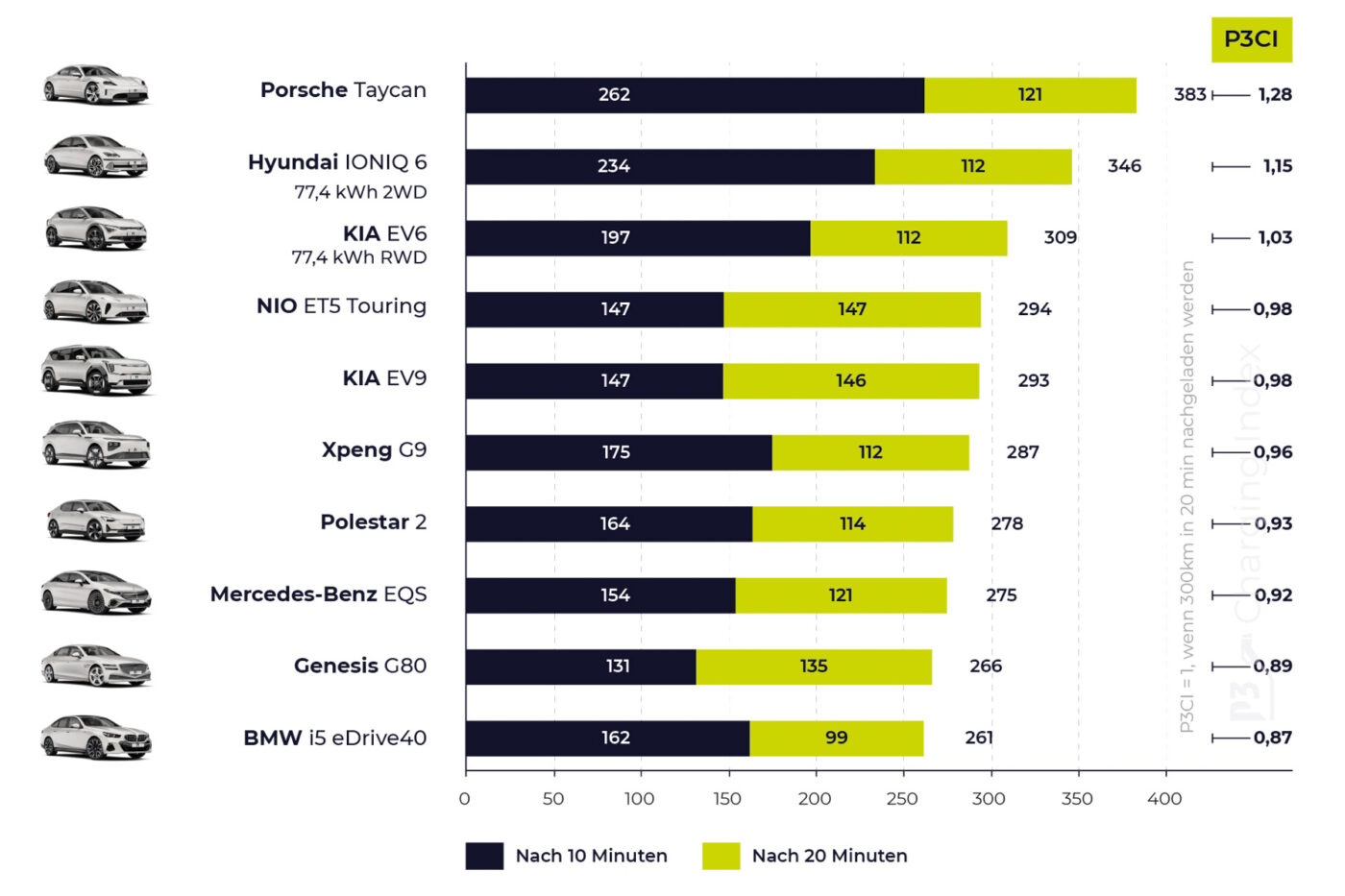
If you combine the upper and middle classes, the Taycan naturally stands out with 383 kilometres recharged in 20 minutes. However, the Ioniq 6 is a good long-distance alternative for just under half of that – with 346 kilometres in 20 minutes. The EV6, the winner in 2022, slips to third place, but the facelift model is due next year.
With the Taycan, a German car manufacturer has regained the top spot in the Charging Index, but the Germans are in the minority in the top ten: alongside the Taycan, the Mercedes EQS (0.92) is in eighth place, while the BMW i5 completes the top ten with 0.87. The other seven cars are built in Asia – four in South Korea and three in China with the Polestar 2, Nio ET5 Touring and Xpeng G9.
Charging performance: advantage for Asia?
What do we learn from all this data? 800-volt systems allow good charging performance, but are no guarantee of a good ranking – consumption must also be right. However, 800 volts has become a prerequisite for doing well in the P3 Charging Index – and also on the road
On the other hand, 400-volt cars with good efficiency and charging curves can certainly be competitive – for now. There is a limit to development here, as efficiency is not increasing at the same rate as the charging curves of some 800-volt models. Charging a battery of over 100 kWh (as in an EQS) with a maximum of 200 kW simply takes too long – given the current market development.
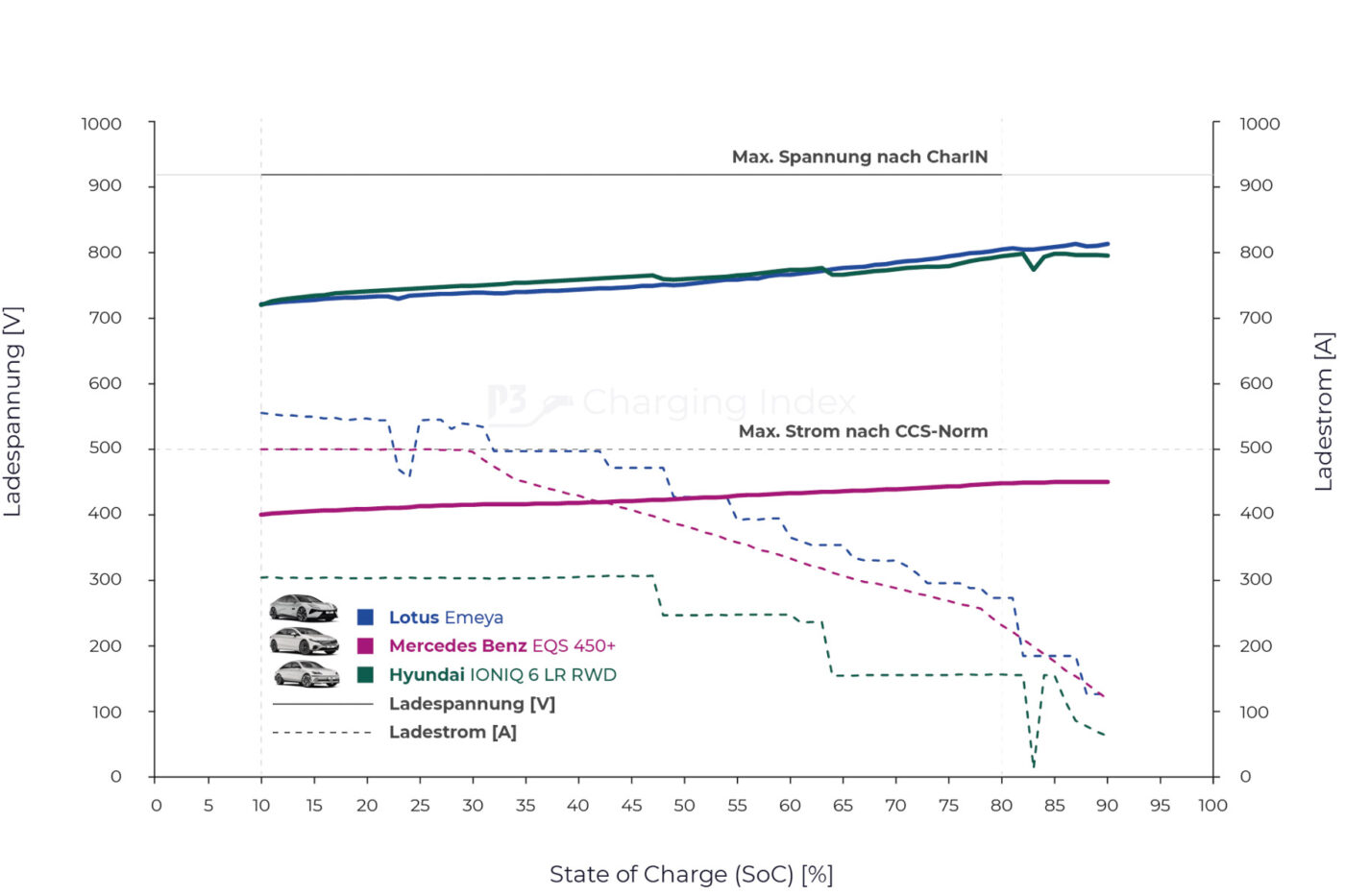
But how do the ever-increasing charging capacities come about? The battery voltage on the one hand and the current on the other are relevant for the charging power. The voltage increases with the charge level during fast charging, but the charging current decreases. Exactly how high the battery voltage is and what current levels the cells can withstand depends on the cell chemistry and also the wiring within the battery. According to P3, Asian manufacturers are expected to have a clear advantage here, as they can access innovative and high-performance technologies earlier in cooperation with Asian battery manufacturers.
One example of this is the Lotus Emeya, which has a charging capacity of over 400 kW. Its battery voltage is between 720 and 800 volts in the charging window from ten to 80 per cent. While a Hyundai Ioniq 6 with a very similar voltage curve is satisfied with a maximum of 300 amperes, Geely can drive up to 550 amperes into the battery of the Lotus Emeya. So even with 800-volt models, the 500-amp limit of CCS has already fallen – and will probably do so in other models in the future!
German manufacturers are not quite at the forefront when it comes to 800 volts, but they have recognised the way forward: Based on the PPE, there are the first models from Porsche and Audi, BMW is also switching to 800 volts with the New Class and Mercedes is also bringing this voltage level to the upcoming CLA. However, while Porsche, Audi and BMW are focussing on SUV models first, Mercedes is playing the efficiency card with the CLA. The next Charging Index will show how that turns out!

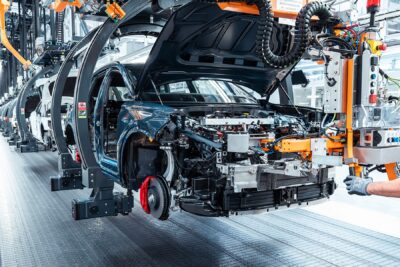
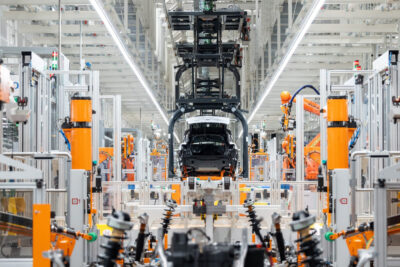
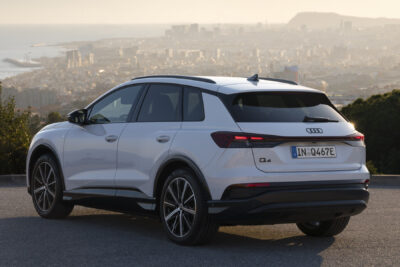
1 Comment